Leading Lean Project: Implementing Lean Project Management
VerifiedAdded on 2022/08/22
|13
|3814
|12
Project
AI Summary
This project management assignment explores the application of Lean principles within the construction of a house, utilizing the Project Management Body of Knowledge (PMBOK) methodology. The assignment details the importance of finalizing client requirements, ensuring effective communication with stakeholders, and successfully managing vendors and subcontractors. It emphasizes the benefits of Lean project management, such as minimizing lead times, reducing costs, and increasing efficiency. The solution outlines the key phases of PMBOK, including initiation, planning, execution, monitoring and controlling, and closing, highlighting how Lean principles can be integrated to enhance project value and eliminate waste. Specific areas covered include defining project scope, managing communication with stakeholders, and managing vendors and subcontractors, with an emphasis on clear communication and efficient processes. The assignment aims to demonstrate how Lean project management can contribute to a more successful and efficient construction project, leading to client satisfaction and project completion within budget and time constraints.

Running head: LEADING LEAN PROJECT
LEADING LEAN PROJECT
Name of the Student
Name of the University
Author Note
LEADING LEAN PROJECT
Name of the Student
Name of the University
Author Note
Paraphrase This Document
Need a fresh take? Get an instant paraphrase of this document with our AI Paraphraser
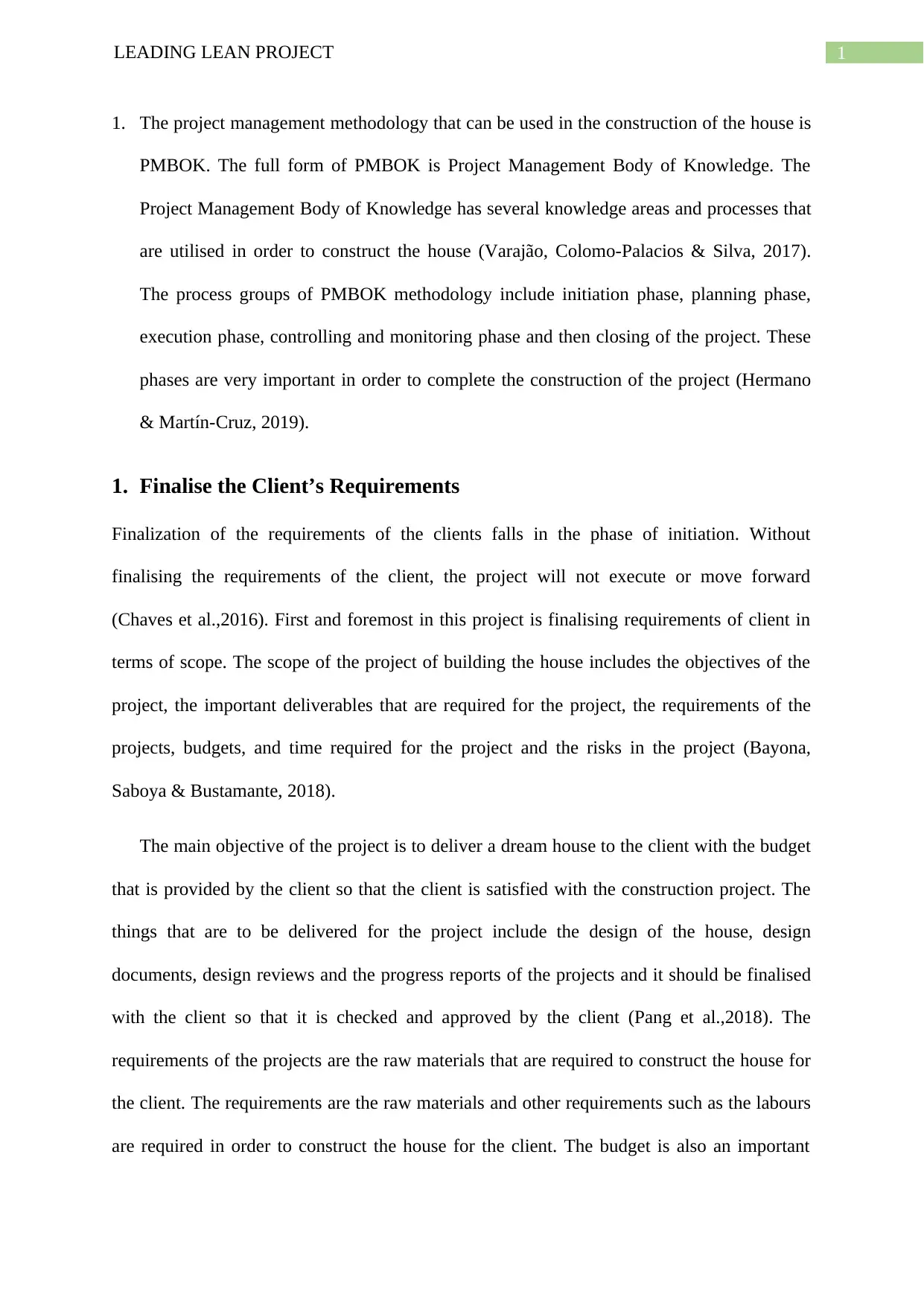
1LEADING LEAN PROJECT
1. The project management methodology that can be used in the construction of the house is
PMBOK. The full form of PMBOK is Project Management Body of Knowledge. The
Project Management Body of Knowledge has several knowledge areas and processes that
are utilised in order to construct the house (Varajão, Colomo-Palacios & Silva, 2017).
The process groups of PMBOK methodology include initiation phase, planning phase,
execution phase, controlling and monitoring phase and then closing of the project. These
phases are very important in order to complete the construction of the project (Hermano
& Martín-Cruz, 2019).
1. Finalise the Client’s Requirements
Finalization of the requirements of the clients falls in the phase of initiation. Without
finalising the requirements of the client, the project will not execute or move forward
(Chaves et al.,2016). First and foremost in this project is finalising requirements of client in
terms of scope. The scope of the project of building the house includes the objectives of the
project, the important deliverables that are required for the project, the requirements of the
projects, budgets, and time required for the project and the risks in the project (Bayona,
Saboya & Bustamante, 2018).
The main objective of the project is to deliver a dream house to the client with the budget
that is provided by the client so that the client is satisfied with the construction project. The
things that are to be delivered for the project include the design of the house, design
documents, design reviews and the progress reports of the projects and it should be finalised
with the client so that it is checked and approved by the client (Pang et al.,2018). The
requirements of the projects are the raw materials that are required to construct the house for
the client. The requirements are the raw materials and other requirements such as the labours
are required in order to construct the house for the client. The budget is also an important
1. The project management methodology that can be used in the construction of the house is
PMBOK. The full form of PMBOK is Project Management Body of Knowledge. The
Project Management Body of Knowledge has several knowledge areas and processes that
are utilised in order to construct the house (Varajão, Colomo-Palacios & Silva, 2017).
The process groups of PMBOK methodology include initiation phase, planning phase,
execution phase, controlling and monitoring phase and then closing of the project. These
phases are very important in order to complete the construction of the project (Hermano
& Martín-Cruz, 2019).
1. Finalise the Client’s Requirements
Finalization of the requirements of the clients falls in the phase of initiation. Without
finalising the requirements of the client, the project will not execute or move forward
(Chaves et al.,2016). First and foremost in this project is finalising requirements of client in
terms of scope. The scope of the project of building the house includes the objectives of the
project, the important deliverables that are required for the project, the requirements of the
projects, budgets, and time required for the project and the risks in the project (Bayona,
Saboya & Bustamante, 2018).
The main objective of the project is to deliver a dream house to the client with the budget
that is provided by the client so that the client is satisfied with the construction project. The
things that are to be delivered for the project include the design of the house, design
documents, design reviews and the progress reports of the projects and it should be finalised
with the client so that it is checked and approved by the client (Pang et al.,2018). The
requirements of the projects are the raw materials that are required to construct the house for
the client. The requirements are the raw materials and other requirements such as the labours
are required in order to construct the house for the client. The budget is also an important
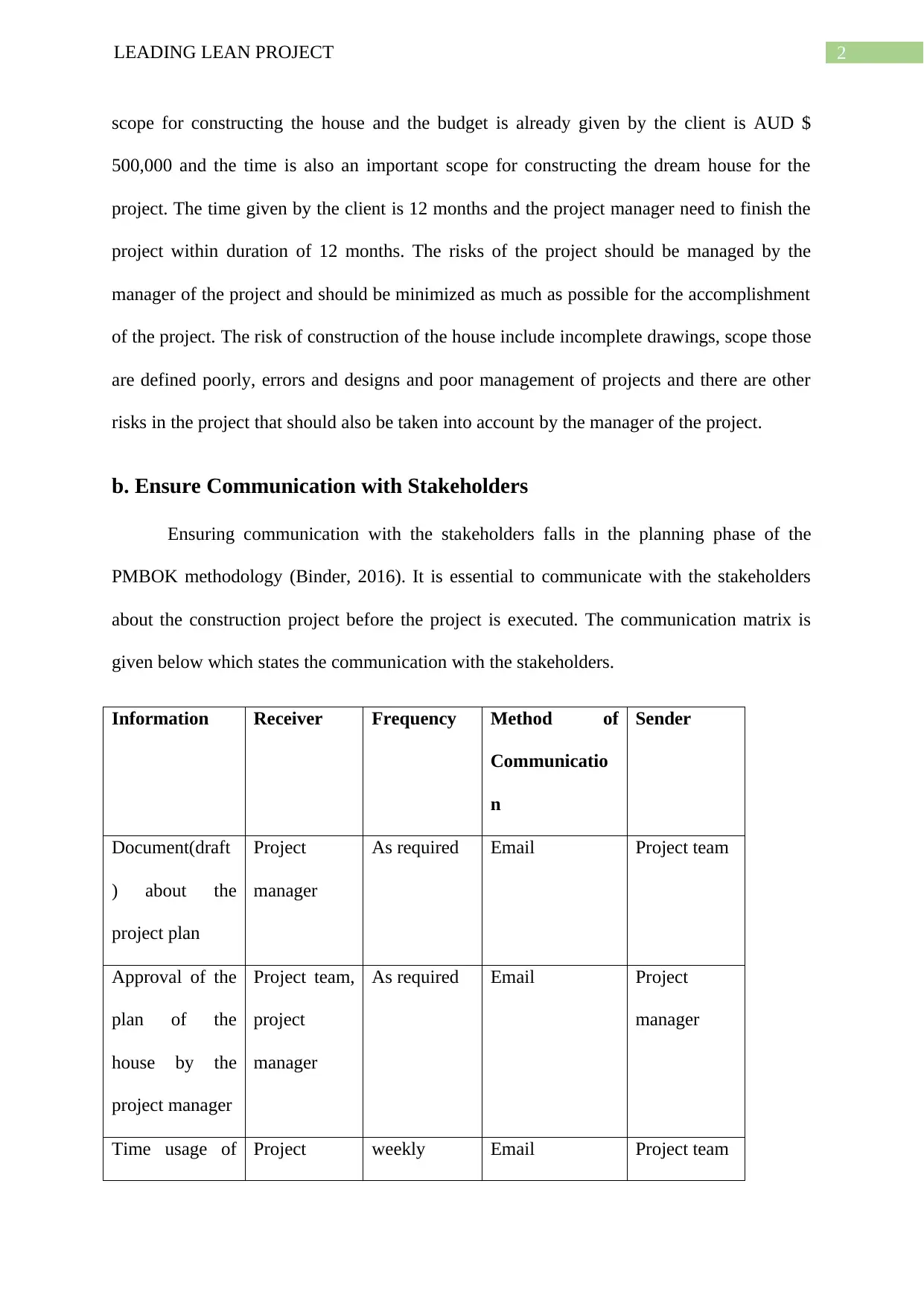
2LEADING LEAN PROJECT
scope for constructing the house and the budget is already given by the client is AUD $
500,000 and the time is also an important scope for constructing the dream house for the
project. The time given by the client is 12 months and the project manager need to finish the
project within duration of 12 months. The risks of the project should be managed by the
manager of the project and should be minimized as much as possible for the accomplishment
of the project. The risk of construction of the house include incomplete drawings, scope those
are defined poorly, errors and designs and poor management of projects and there are other
risks in the project that should also be taken into account by the manager of the project.
b. Ensure Communication with Stakeholders
Ensuring communication with the stakeholders falls in the planning phase of the
PMBOK methodology (Binder, 2016). It is essential to communicate with the stakeholders
about the construction project before the project is executed. The communication matrix is
given below which states the communication with the stakeholders.
Information Receiver Frequency Method of
Communicatio
n
Sender
Document(draft
) about the
project plan
Project
manager
As required Email Project team
Approval of the
plan of the
house by the
project manager
Project team,
project
manager
As required Email Project
manager
Time usage of Project weekly Email Project team
scope for constructing the house and the budget is already given by the client is AUD $
500,000 and the time is also an important scope for constructing the dream house for the
project. The time given by the client is 12 months and the project manager need to finish the
project within duration of 12 months. The risks of the project should be managed by the
manager of the project and should be minimized as much as possible for the accomplishment
of the project. The risk of construction of the house include incomplete drawings, scope those
are defined poorly, errors and designs and poor management of projects and there are other
risks in the project that should also be taken into account by the manager of the project.
b. Ensure Communication with Stakeholders
Ensuring communication with the stakeholders falls in the planning phase of the
PMBOK methodology (Binder, 2016). It is essential to communicate with the stakeholders
about the construction project before the project is executed. The communication matrix is
given below which states the communication with the stakeholders.
Information Receiver Frequency Method of
Communicatio
n
Sender
Document(draft
) about the
project plan
Project
manager
As required Email Project team
Approval of the
plan of the
house by the
project manager
Project team,
project
manager
As required Email Project
manager
Time usage of Project weekly Email Project team
⊘ This is a preview!⊘
Do you want full access?
Subscribe today to unlock all pages.

Trusted by 1+ million students worldwide
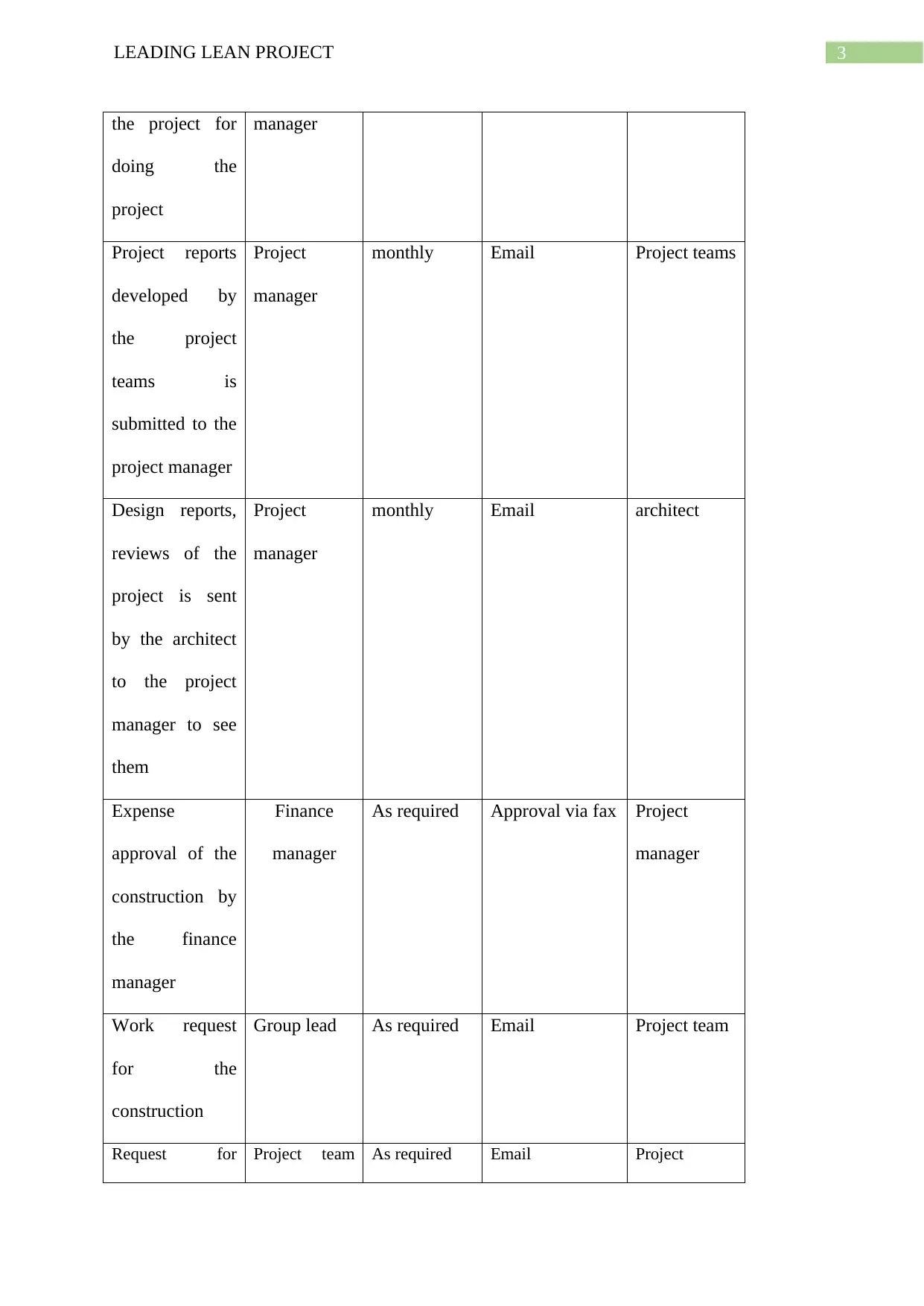
3LEADING LEAN PROJECT
the project for
doing the
project
manager
Project reports
developed by
the project
teams is
submitted to the
project manager
Project
manager
monthly Email Project teams
Design reports,
reviews of the
project is sent
by the architect
to the project
manager to see
them
Project
manager
monthly Email architect
Expense
approval of the
construction by
the finance
manager
Finance
manager
As required Approval via fax Project
manager
Work request
for the
construction
Group lead As required Email Project team
Request for Project team As required Email Project
the project for
doing the
project
manager
Project reports
developed by
the project
teams is
submitted to the
project manager
Project
manager
monthly Email Project teams
Design reports,
reviews of the
project is sent
by the architect
to the project
manager to see
them
Project
manager
monthly Email architect
Expense
approval of the
construction by
the finance
manager
Finance
manager
As required Approval via fax Project
manager
Work request
for the
construction
Group lead As required Email Project team
Request for Project team As required Email Project
Paraphrase This Document
Need a fresh take? Get an instant paraphrase of this document with our AI Paraphraser
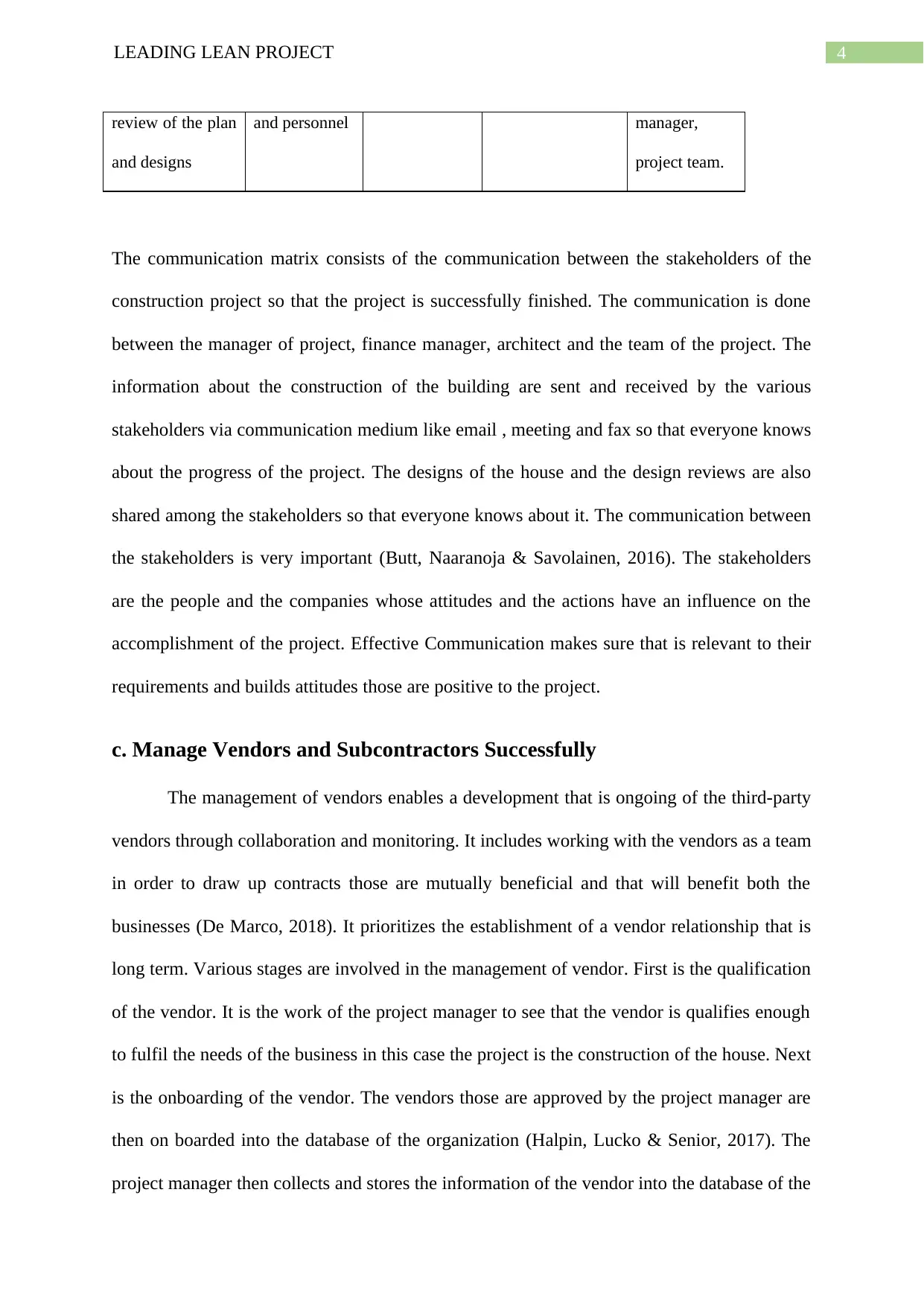
4LEADING LEAN PROJECT
review of the plan
and designs
and personnel manager,
project team.
The communication matrix consists of the communication between the stakeholders of the
construction project so that the project is successfully finished. The communication is done
between the manager of project, finance manager, architect and the team of the project. The
information about the construction of the building are sent and received by the various
stakeholders via communication medium like email , meeting and fax so that everyone knows
about the progress of the project. The designs of the house and the design reviews are also
shared among the stakeholders so that everyone knows about it. The communication between
the stakeholders is very important (Butt, Naaranoja & Savolainen, 2016). The stakeholders
are the people and the companies whose attitudes and the actions have an influence on the
accomplishment of the project. Effective Communication makes sure that is relevant to their
requirements and builds attitudes those are positive to the project.
c. Manage Vendors and Subcontractors Successfully
The management of vendors enables a development that is ongoing of the third-party
vendors through collaboration and monitoring. It includes working with the vendors as a team
in order to draw up contracts those are mutually beneficial and that will benefit both the
businesses (De Marco, 2018). It prioritizes the establishment of a vendor relationship that is
long term. Various stages are involved in the management of vendor. First is the qualification
of the vendor. It is the work of the project manager to see that the vendor is qualifies enough
to fulfil the needs of the business in this case the project is the construction of the house. Next
is the onboarding of the vendor. The vendors those are approved by the project manager are
then on boarded into the database of the organization (Halpin, Lucko & Senior, 2017). The
project manager then collects and stores the information of the vendor into the database of the
review of the plan
and designs
and personnel manager,
project team.
The communication matrix consists of the communication between the stakeholders of the
construction project so that the project is successfully finished. The communication is done
between the manager of project, finance manager, architect and the team of the project. The
information about the construction of the building are sent and received by the various
stakeholders via communication medium like email , meeting and fax so that everyone knows
about the progress of the project. The designs of the house and the design reviews are also
shared among the stakeholders so that everyone knows about it. The communication between
the stakeholders is very important (Butt, Naaranoja & Savolainen, 2016). The stakeholders
are the people and the companies whose attitudes and the actions have an influence on the
accomplishment of the project. Effective Communication makes sure that is relevant to their
requirements and builds attitudes those are positive to the project.
c. Manage Vendors and Subcontractors Successfully
The management of vendors enables a development that is ongoing of the third-party
vendors through collaboration and monitoring. It includes working with the vendors as a team
in order to draw up contracts those are mutually beneficial and that will benefit both the
businesses (De Marco, 2018). It prioritizes the establishment of a vendor relationship that is
long term. Various stages are involved in the management of vendor. First is the qualification
of the vendor. It is the work of the project manager to see that the vendor is qualifies enough
to fulfil the needs of the business in this case the project is the construction of the house. Next
is the onboarding of the vendor. The vendors those are approved by the project manager are
then on boarded into the database of the organization (Halpin, Lucko & Senior, 2017). The
project manager then collects and stores the information of the vendor into the database of the
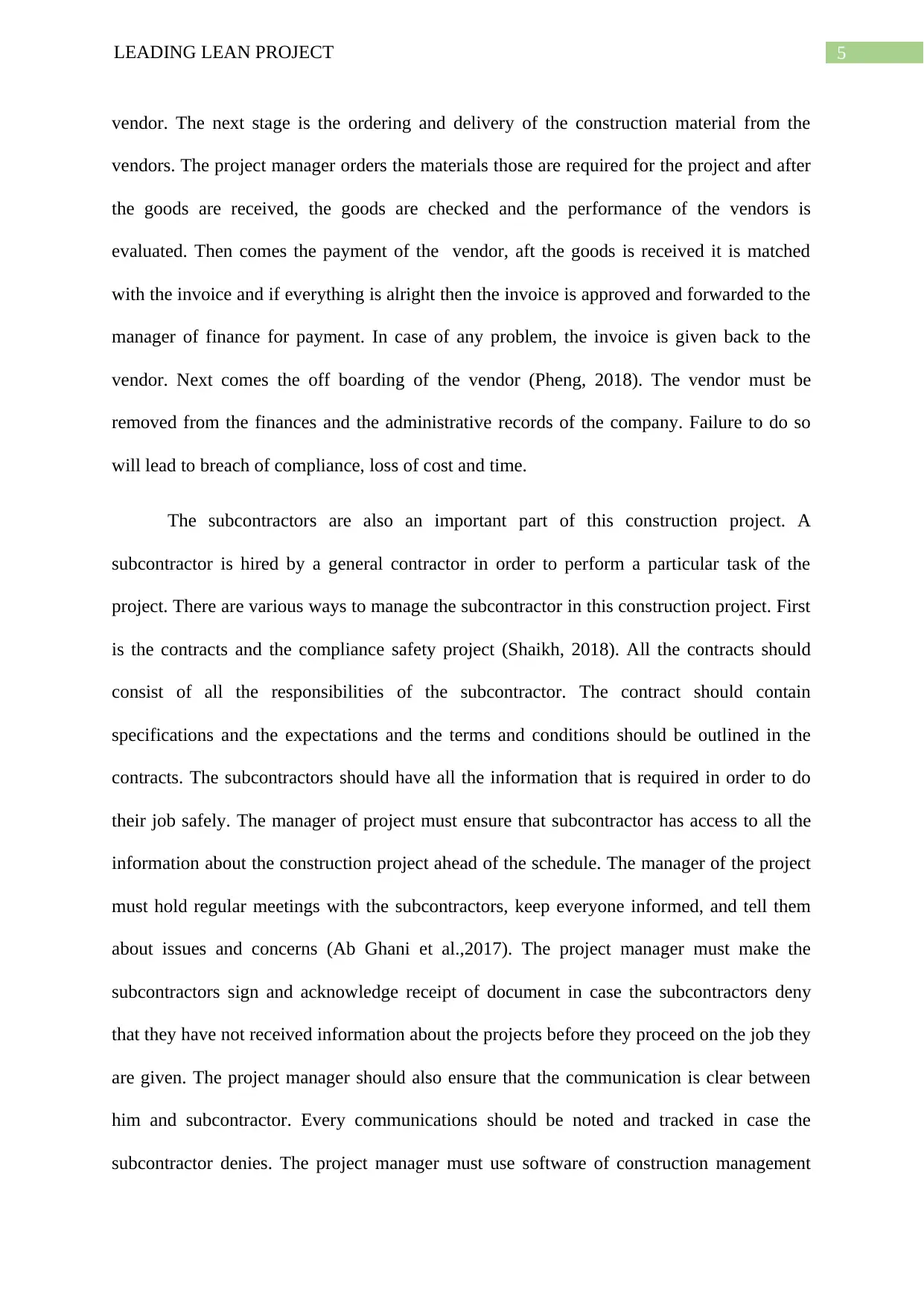
5LEADING LEAN PROJECT
vendor. The next stage is the ordering and delivery of the construction material from the
vendors. The project manager orders the materials those are required for the project and after
the goods are received, the goods are checked and the performance of the vendors is
evaluated. Then comes the payment of the vendor, aft the goods is received it is matched
with the invoice and if everything is alright then the invoice is approved and forwarded to the
manager of finance for payment. In case of any problem, the invoice is given back to the
vendor. Next comes the off boarding of the vendor (Pheng, 2018). The vendor must be
removed from the finances and the administrative records of the company. Failure to do so
will lead to breach of compliance, loss of cost and time.
The subcontractors are also an important part of this construction project. A
subcontractor is hired by a general contractor in order to perform a particular task of the
project. There are various ways to manage the subcontractor in this construction project. First
is the contracts and the compliance safety project (Shaikh, 2018). All the contracts should
consist of all the responsibilities of the subcontractor. The contract should contain
specifications and the expectations and the terms and conditions should be outlined in the
contracts. The subcontractors should have all the information that is required in order to do
their job safely. The manager of project must ensure that subcontractor has access to all the
information about the construction project ahead of the schedule. The manager of the project
must hold regular meetings with the subcontractors, keep everyone informed, and tell them
about issues and concerns (Ab Ghani et al.,2017). The project manager must make the
subcontractors sign and acknowledge receipt of document in case the subcontractors deny
that they have not received information about the projects before they proceed on the job they
are given. The project manager should also ensure that the communication is clear between
him and subcontractor. Every communications should be noted and tracked in case the
subcontractor denies. The project manager must use software of construction management
vendor. The next stage is the ordering and delivery of the construction material from the
vendors. The project manager orders the materials those are required for the project and after
the goods are received, the goods are checked and the performance of the vendors is
evaluated. Then comes the payment of the vendor, aft the goods is received it is matched
with the invoice and if everything is alright then the invoice is approved and forwarded to the
manager of finance for payment. In case of any problem, the invoice is given back to the
vendor. Next comes the off boarding of the vendor (Pheng, 2018). The vendor must be
removed from the finances and the administrative records of the company. Failure to do so
will lead to breach of compliance, loss of cost and time.
The subcontractors are also an important part of this construction project. A
subcontractor is hired by a general contractor in order to perform a particular task of the
project. There are various ways to manage the subcontractor in this construction project. First
is the contracts and the compliance safety project (Shaikh, 2018). All the contracts should
consist of all the responsibilities of the subcontractor. The contract should contain
specifications and the expectations and the terms and conditions should be outlined in the
contracts. The subcontractors should have all the information that is required in order to do
their job safely. The manager of project must ensure that subcontractor has access to all the
information about the construction project ahead of the schedule. The manager of the project
must hold regular meetings with the subcontractors, keep everyone informed, and tell them
about issues and concerns (Ab Ghani et al.,2017). The project manager must make the
subcontractors sign and acknowledge receipt of document in case the subcontractors deny
that they have not received information about the projects before they proceed on the job they
are given. The project manager should also ensure that the communication is clear between
him and subcontractor. Every communications should be noted and tracked in case the
subcontractor denies. The project manager must use software of construction management
⊘ This is a preview!⊘
Do you want full access?
Subscribe today to unlock all pages.

Trusted by 1+ million students worldwide
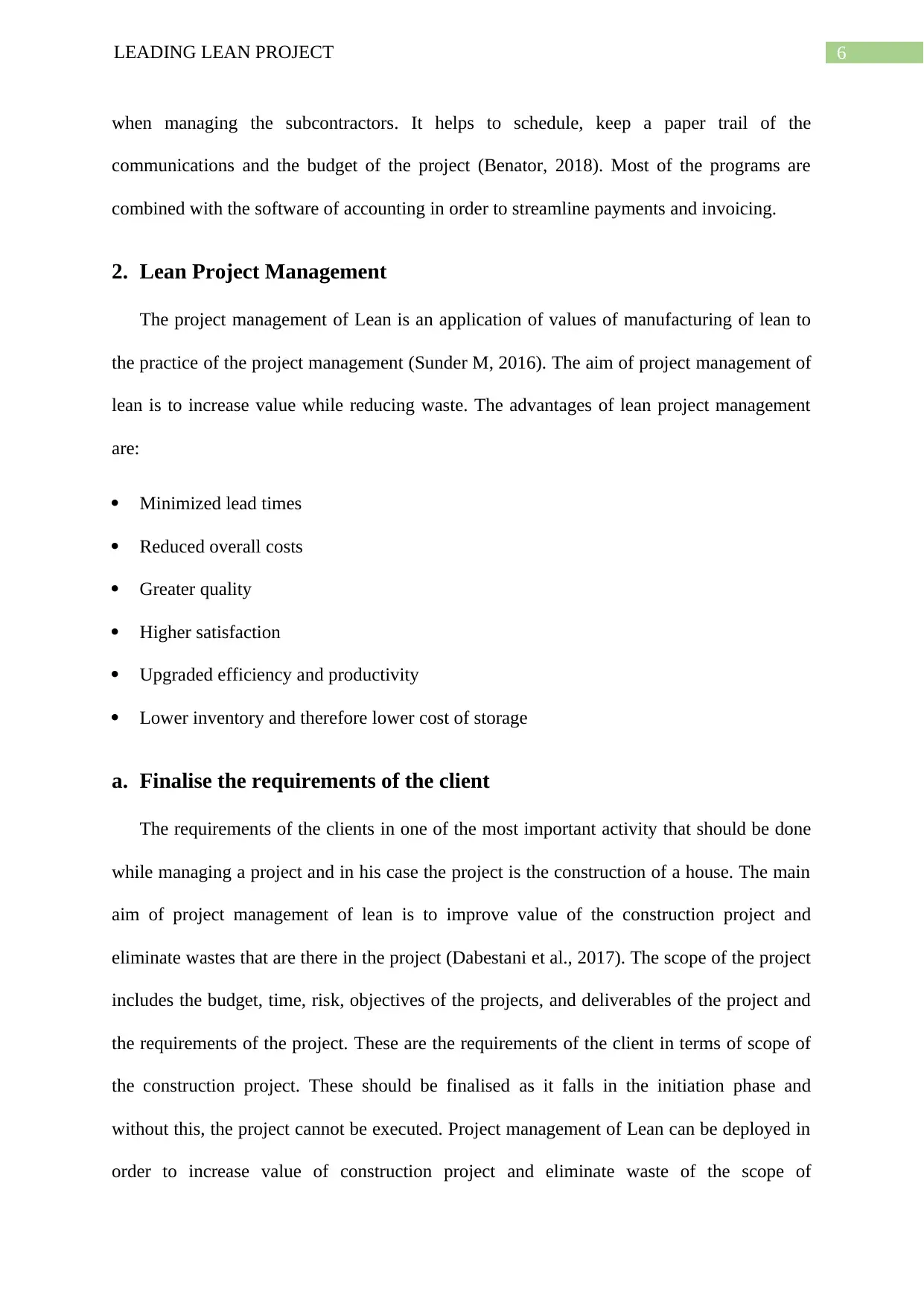
6LEADING LEAN PROJECT
when managing the subcontractors. It helps to schedule, keep a paper trail of the
communications and the budget of the project (Benator, 2018). Most of the programs are
combined with the software of accounting in order to streamline payments and invoicing.
2. Lean Project Management
The project management of Lean is an application of values of manufacturing of lean to
the practice of the project management (Sunder M, 2016). The aim of project management of
lean is to increase value while reducing waste. The advantages of lean project management
are:
Minimized lead times
Reduced overall costs
Greater quality
Higher satisfaction
Upgraded efficiency and productivity
Lower inventory and therefore lower cost of storage
a. Finalise the requirements of the client
The requirements of the clients in one of the most important activity that should be done
while managing a project and in his case the project is the construction of a house. The main
aim of project management of lean is to improve value of the construction project and
eliminate wastes that are there in the project (Dabestani et al., 2017). The scope of the project
includes the budget, time, risk, objectives of the projects, and deliverables of the project and
the requirements of the project. These are the requirements of the client in terms of scope of
the construction project. These should be finalised as it falls in the initiation phase and
without this, the project cannot be executed. Project management of Lean can be deployed in
order to increase value of construction project and eliminate waste of the scope of
when managing the subcontractors. It helps to schedule, keep a paper trail of the
communications and the budget of the project (Benator, 2018). Most of the programs are
combined with the software of accounting in order to streamline payments and invoicing.
2. Lean Project Management
The project management of Lean is an application of values of manufacturing of lean to
the practice of the project management (Sunder M, 2016). The aim of project management of
lean is to increase value while reducing waste. The advantages of lean project management
are:
Minimized lead times
Reduced overall costs
Greater quality
Higher satisfaction
Upgraded efficiency and productivity
Lower inventory and therefore lower cost of storage
a. Finalise the requirements of the client
The requirements of the clients in one of the most important activity that should be done
while managing a project and in his case the project is the construction of a house. The main
aim of project management of lean is to improve value of the construction project and
eliminate wastes that are there in the project (Dabestani et al., 2017). The scope of the project
includes the budget, time, risk, objectives of the projects, and deliverables of the project and
the requirements of the project. These are the requirements of the client in terms of scope of
the construction project. These should be finalised as it falls in the initiation phase and
without this, the project cannot be executed. Project management of Lean can be deployed in
order to increase value of construction project and eliminate waste of the scope of
Paraphrase This Document
Need a fresh take? Get an instant paraphrase of this document with our AI Paraphraser
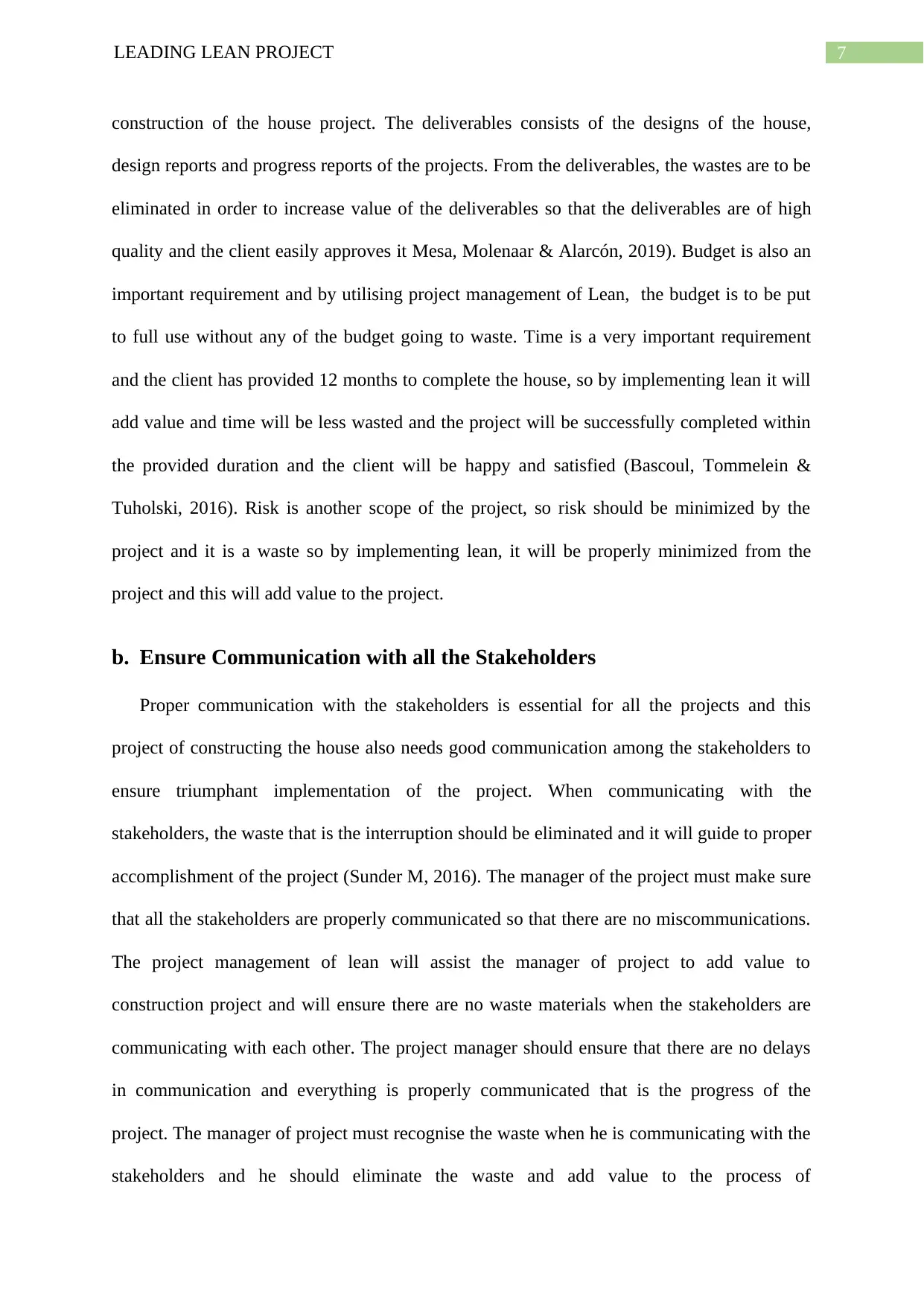
7LEADING LEAN PROJECT
construction of the house project. The deliverables consists of the designs of the house,
design reports and progress reports of the projects. From the deliverables, the wastes are to be
eliminated in order to increase value of the deliverables so that the deliverables are of high
quality and the client easily approves it Mesa, Molenaar & Alarcón, 2019). Budget is also an
important requirement and by utilising project management of Lean, the budget is to be put
to full use without any of the budget going to waste. Time is a very important requirement
and the client has provided 12 months to complete the house, so by implementing lean it will
add value and time will be less wasted and the project will be successfully completed within
the provided duration and the client will be happy and satisfied (Bascoul, Tommelein &
Tuholski, 2016). Risk is another scope of the project, so risk should be minimized by the
project and it is a waste so by implementing lean, it will be properly minimized from the
project and this will add value to the project.
b. Ensure Communication with all the Stakeholders
Proper communication with the stakeholders is essential for all the projects and this
project of constructing the house also needs good communication among the stakeholders to
ensure triumphant implementation of the project. When communicating with the
stakeholders, the waste that is the interruption should be eliminated and it will guide to proper
accomplishment of the project (Sunder M, 2016). The manager of the project must make sure
that all the stakeholders are properly communicated so that there are no miscommunications.
The project management of lean will assist the manager of project to add value to
construction project and will ensure there are no waste materials when the stakeholders are
communicating with each other. The project manager should ensure that there are no delays
in communication and everything is properly communicated that is the progress of the
project. The manager of project must recognise the waste when he is communicating with the
stakeholders and he should eliminate the waste and add value to the process of
construction of the house project. The deliverables consists of the designs of the house,
design reports and progress reports of the projects. From the deliverables, the wastes are to be
eliminated in order to increase value of the deliverables so that the deliverables are of high
quality and the client easily approves it Mesa, Molenaar & Alarcón, 2019). Budget is also an
important requirement and by utilising project management of Lean, the budget is to be put
to full use without any of the budget going to waste. Time is a very important requirement
and the client has provided 12 months to complete the house, so by implementing lean it will
add value and time will be less wasted and the project will be successfully completed within
the provided duration and the client will be happy and satisfied (Bascoul, Tommelein &
Tuholski, 2016). Risk is another scope of the project, so risk should be minimized by the
project and it is a waste so by implementing lean, it will be properly minimized from the
project and this will add value to the project.
b. Ensure Communication with all the Stakeholders
Proper communication with the stakeholders is essential for all the projects and this
project of constructing the house also needs good communication among the stakeholders to
ensure triumphant implementation of the project. When communicating with the
stakeholders, the waste that is the interruption should be eliminated and it will guide to proper
accomplishment of the project (Sunder M, 2016). The manager of the project must make sure
that all the stakeholders are properly communicated so that there are no miscommunications.
The project management of lean will assist the manager of project to add value to
construction project and will ensure there are no waste materials when the stakeholders are
communicating with each other. The project manager should ensure that there are no delays
in communication and everything is properly communicated that is the progress of the
project. The manager of project must recognise the waste when he is communicating with the
stakeholders and he should eliminate the waste and add value to the process of
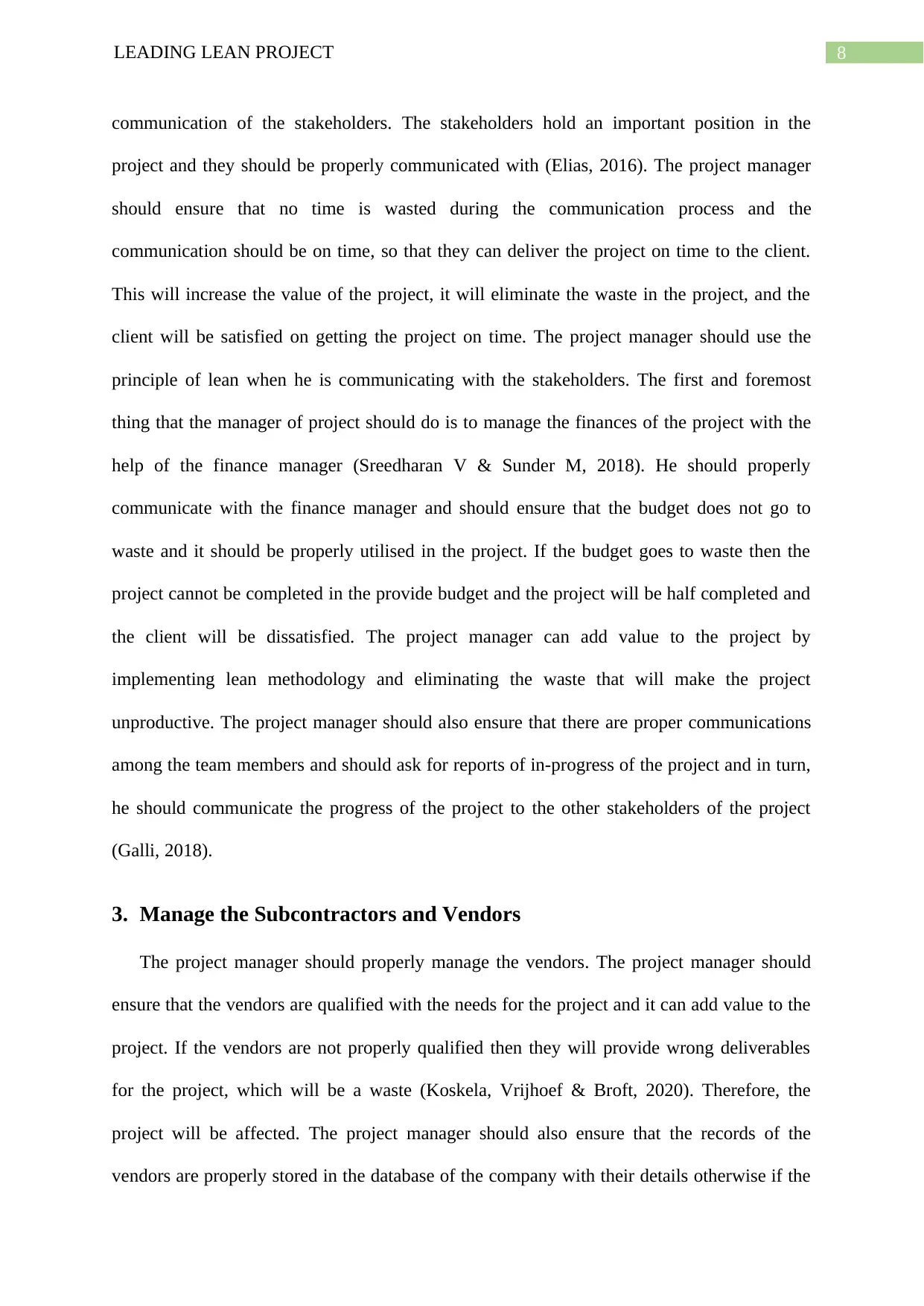
8LEADING LEAN PROJECT
communication of the stakeholders. The stakeholders hold an important position in the
project and they should be properly communicated with (Elias, 2016). The project manager
should ensure that no time is wasted during the communication process and the
communication should be on time, so that they can deliver the project on time to the client.
This will increase the value of the project, it will eliminate the waste in the project, and the
client will be satisfied on getting the project on time. The project manager should use the
principle of lean when he is communicating with the stakeholders. The first and foremost
thing that the manager of project should do is to manage the finances of the project with the
help of the finance manager (Sreedharan V & Sunder M, 2018). He should properly
communicate with the finance manager and should ensure that the budget does not go to
waste and it should be properly utilised in the project. If the budget goes to waste then the
project cannot be completed in the provide budget and the project will be half completed and
the client will be dissatisfied. The project manager can add value to the project by
implementing lean methodology and eliminating the waste that will make the project
unproductive. The project manager should also ensure that there are proper communications
among the team members and should ask for reports of in-progress of the project and in turn,
he should communicate the progress of the project to the other stakeholders of the project
(Galli, 2018).
3. Manage the Subcontractors and Vendors
The project manager should properly manage the vendors. The project manager should
ensure that the vendors are qualified with the needs for the project and it can add value to the
project. If the vendors are not properly qualified then they will provide wrong deliverables
for the project, which will be a waste (Koskela, Vrijhoef & Broft, 2020). Therefore, the
project will be affected. The project manager should also ensure that the records of the
vendors are properly stored in the database of the company with their details otherwise if the
communication of the stakeholders. The stakeholders hold an important position in the
project and they should be properly communicated with (Elias, 2016). The project manager
should ensure that no time is wasted during the communication process and the
communication should be on time, so that they can deliver the project on time to the client.
This will increase the value of the project, it will eliminate the waste in the project, and the
client will be satisfied on getting the project on time. The project manager should use the
principle of lean when he is communicating with the stakeholders. The first and foremost
thing that the manager of project should do is to manage the finances of the project with the
help of the finance manager (Sreedharan V & Sunder M, 2018). He should properly
communicate with the finance manager and should ensure that the budget does not go to
waste and it should be properly utilised in the project. If the budget goes to waste then the
project cannot be completed in the provide budget and the project will be half completed and
the client will be dissatisfied. The project manager can add value to the project by
implementing lean methodology and eliminating the waste that will make the project
unproductive. The project manager should also ensure that there are proper communications
among the team members and should ask for reports of in-progress of the project and in turn,
he should communicate the progress of the project to the other stakeholders of the project
(Galli, 2018).
3. Manage the Subcontractors and Vendors
The project manager should properly manage the vendors. The project manager should
ensure that the vendors are qualified with the needs for the project and it can add value to the
project. If the vendors are not properly qualified then they will provide wrong deliverables
for the project, which will be a waste (Koskela, Vrijhoef & Broft, 2020). Therefore, the
project will be affected. The project manager should also ensure that the records of the
vendors are properly stored in the database of the company with their details otherwise if the
⊘ This is a preview!⊘
Do you want full access?
Subscribe today to unlock all pages.

Trusted by 1+ million students worldwide
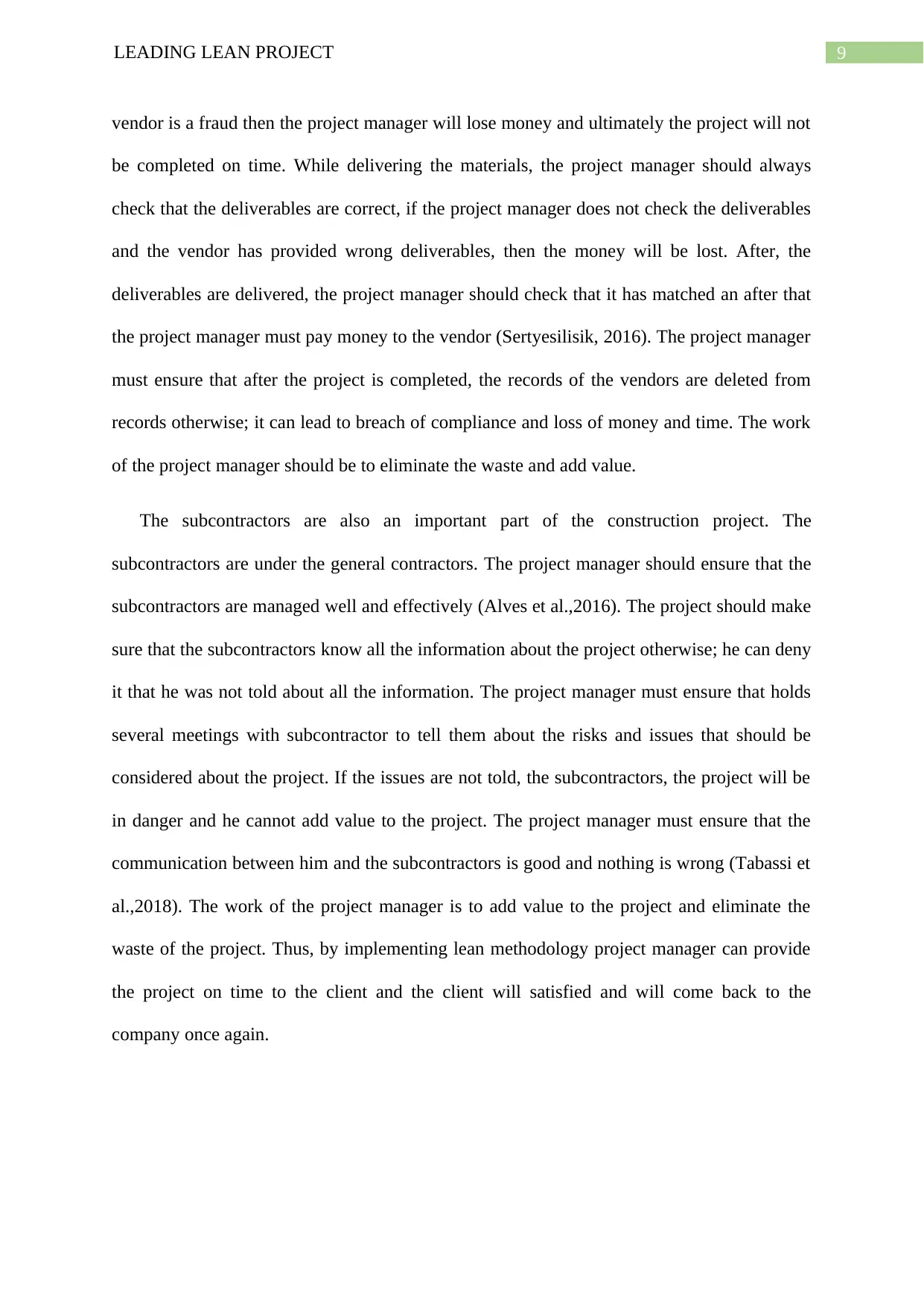
9LEADING LEAN PROJECT
vendor is a fraud then the project manager will lose money and ultimately the project will not
be completed on time. While delivering the materials, the project manager should always
check that the deliverables are correct, if the project manager does not check the deliverables
and the vendor has provided wrong deliverables, then the money will be lost. After, the
deliverables are delivered, the project manager should check that it has matched an after that
the project manager must pay money to the vendor (Sertyesilisik, 2016). The project manager
must ensure that after the project is completed, the records of the vendors are deleted from
records otherwise; it can lead to breach of compliance and loss of money and time. The work
of the project manager should be to eliminate the waste and add value.
The subcontractors are also an important part of the construction project. The
subcontractors are under the general contractors. The project manager should ensure that the
subcontractors are managed well and effectively (Alves et al.,2016). The project should make
sure that the subcontractors know all the information about the project otherwise; he can deny
it that he was not told about all the information. The project manager must ensure that holds
several meetings with subcontractor to tell them about the risks and issues that should be
considered about the project. If the issues are not told, the subcontractors, the project will be
in danger and he cannot add value to the project. The project manager must ensure that the
communication between him and the subcontractors is good and nothing is wrong (Tabassi et
al.,2018). The work of the project manager is to add value to the project and eliminate the
waste of the project. Thus, by implementing lean methodology project manager can provide
the project on time to the client and the client will satisfied and will come back to the
company once again.
vendor is a fraud then the project manager will lose money and ultimately the project will not
be completed on time. While delivering the materials, the project manager should always
check that the deliverables are correct, if the project manager does not check the deliverables
and the vendor has provided wrong deliverables, then the money will be lost. After, the
deliverables are delivered, the project manager should check that it has matched an after that
the project manager must pay money to the vendor (Sertyesilisik, 2016). The project manager
must ensure that after the project is completed, the records of the vendors are deleted from
records otherwise; it can lead to breach of compliance and loss of money and time. The work
of the project manager should be to eliminate the waste and add value.
The subcontractors are also an important part of the construction project. The
subcontractors are under the general contractors. The project manager should ensure that the
subcontractors are managed well and effectively (Alves et al.,2016). The project should make
sure that the subcontractors know all the information about the project otherwise; he can deny
it that he was not told about all the information. The project manager must ensure that holds
several meetings with subcontractor to tell them about the risks and issues that should be
considered about the project. If the issues are not told, the subcontractors, the project will be
in danger and he cannot add value to the project. The project manager must ensure that the
communication between him and the subcontractors is good and nothing is wrong (Tabassi et
al.,2018). The work of the project manager is to add value to the project and eliminate the
waste of the project. Thus, by implementing lean methodology project manager can provide
the project on time to the client and the client will satisfied and will come back to the
company once again.
Paraphrase This Document
Need a fresh take? Get an instant paraphrase of this document with our AI Paraphraser
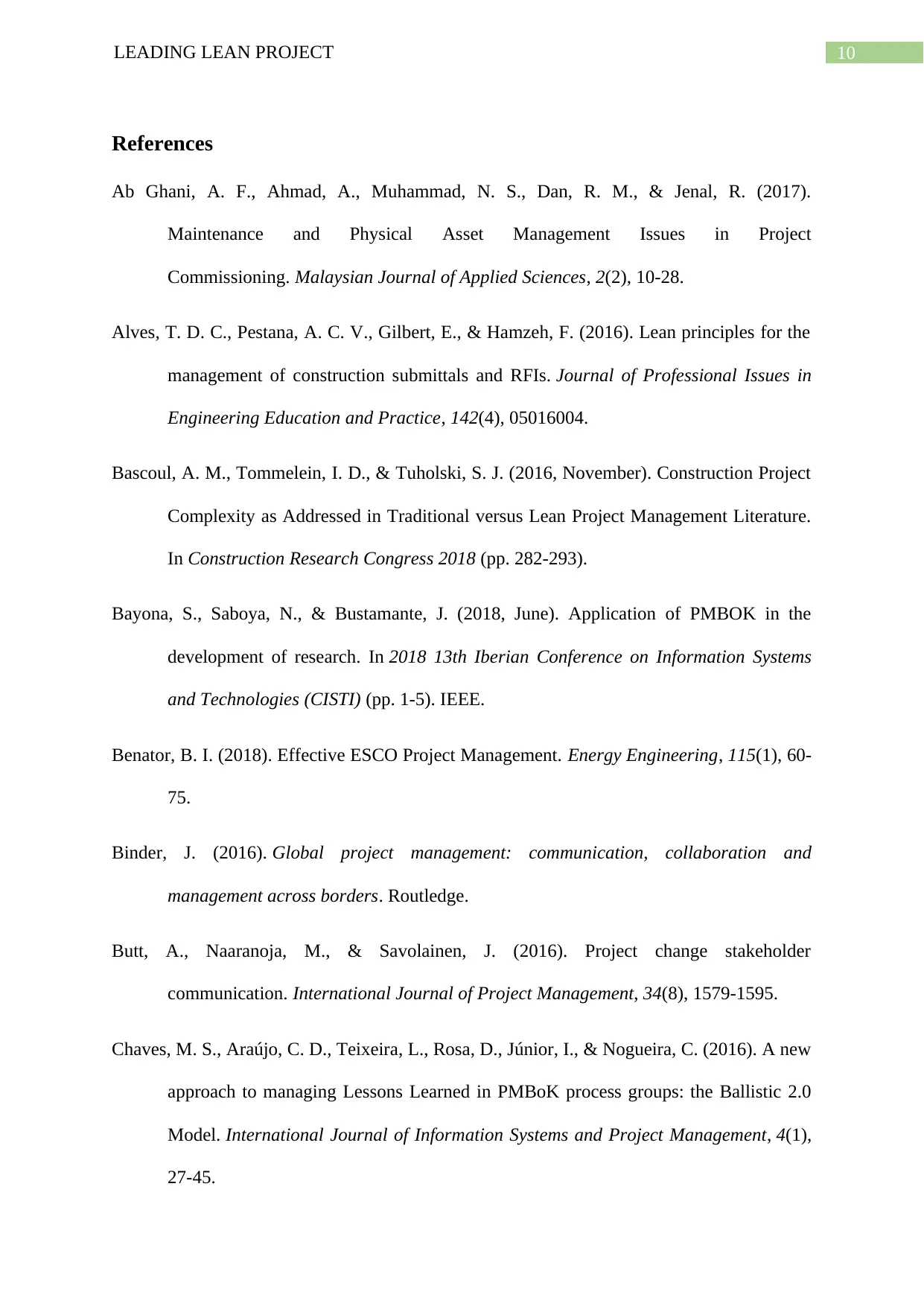
10LEADING LEAN PROJECT
References
Ab Ghani, A. F., Ahmad, A., Muhammad, N. S., Dan, R. M., & Jenal, R. (2017).
Maintenance and Physical Asset Management Issues in Project
Commissioning. Malaysian Journal of Applied Sciences, 2(2), 10-28.
Alves, T. D. C., Pestana, A. C. V., Gilbert, E., & Hamzeh, F. (2016). Lean principles for the
management of construction submittals and RFIs. Journal of Professional Issues in
Engineering Education and Practice, 142(4), 05016004.
Bascoul, A. M., Tommelein, I. D., & Tuholski, S. J. (2016, November). Construction Project
Complexity as Addressed in Traditional versus Lean Project Management Literature.
In Construction Research Congress 2018 (pp. 282-293).
Bayona, S., Saboya, N., & Bustamante, J. (2018, June). Application of PMBOK in the
development of research. In 2018 13th Iberian Conference on Information Systems
and Technologies (CISTI) (pp. 1-5). IEEE.
Benator, B. I. (2018). Effective ESCO Project Management. Energy Engineering, 115(1), 60-
75.
Binder, J. (2016). Global project management: communication, collaboration and
management across borders. Routledge.
Butt, A., Naaranoja, M., & Savolainen, J. (2016). Project change stakeholder
communication. International Journal of Project Management, 34(8), 1579-1595.
Chaves, M. S., Araújo, C. D., Teixeira, L., Rosa, D., Júnior, I., & Nogueira, C. (2016). A new
approach to managing Lessons Learned in PMBoK process groups: the Ballistic 2.0
Model. International Journal of Information Systems and Project Management, 4(1),
27-45.
References
Ab Ghani, A. F., Ahmad, A., Muhammad, N. S., Dan, R. M., & Jenal, R. (2017).
Maintenance and Physical Asset Management Issues in Project
Commissioning. Malaysian Journal of Applied Sciences, 2(2), 10-28.
Alves, T. D. C., Pestana, A. C. V., Gilbert, E., & Hamzeh, F. (2016). Lean principles for the
management of construction submittals and RFIs. Journal of Professional Issues in
Engineering Education and Practice, 142(4), 05016004.
Bascoul, A. M., Tommelein, I. D., & Tuholski, S. J. (2016, November). Construction Project
Complexity as Addressed in Traditional versus Lean Project Management Literature.
In Construction Research Congress 2018 (pp. 282-293).
Bayona, S., Saboya, N., & Bustamante, J. (2018, June). Application of PMBOK in the
development of research. In 2018 13th Iberian Conference on Information Systems
and Technologies (CISTI) (pp. 1-5). IEEE.
Benator, B. I. (2018). Effective ESCO Project Management. Energy Engineering, 115(1), 60-
75.
Binder, J. (2016). Global project management: communication, collaboration and
management across borders. Routledge.
Butt, A., Naaranoja, M., & Savolainen, J. (2016). Project change stakeholder
communication. International Journal of Project Management, 34(8), 1579-1595.
Chaves, M. S., Araújo, C. D., Teixeira, L., Rosa, D., Júnior, I., & Nogueira, C. (2016). A new
approach to managing Lessons Learned in PMBoK process groups: the Ballistic 2.0
Model. International Journal of Information Systems and Project Management, 4(1),
27-45.
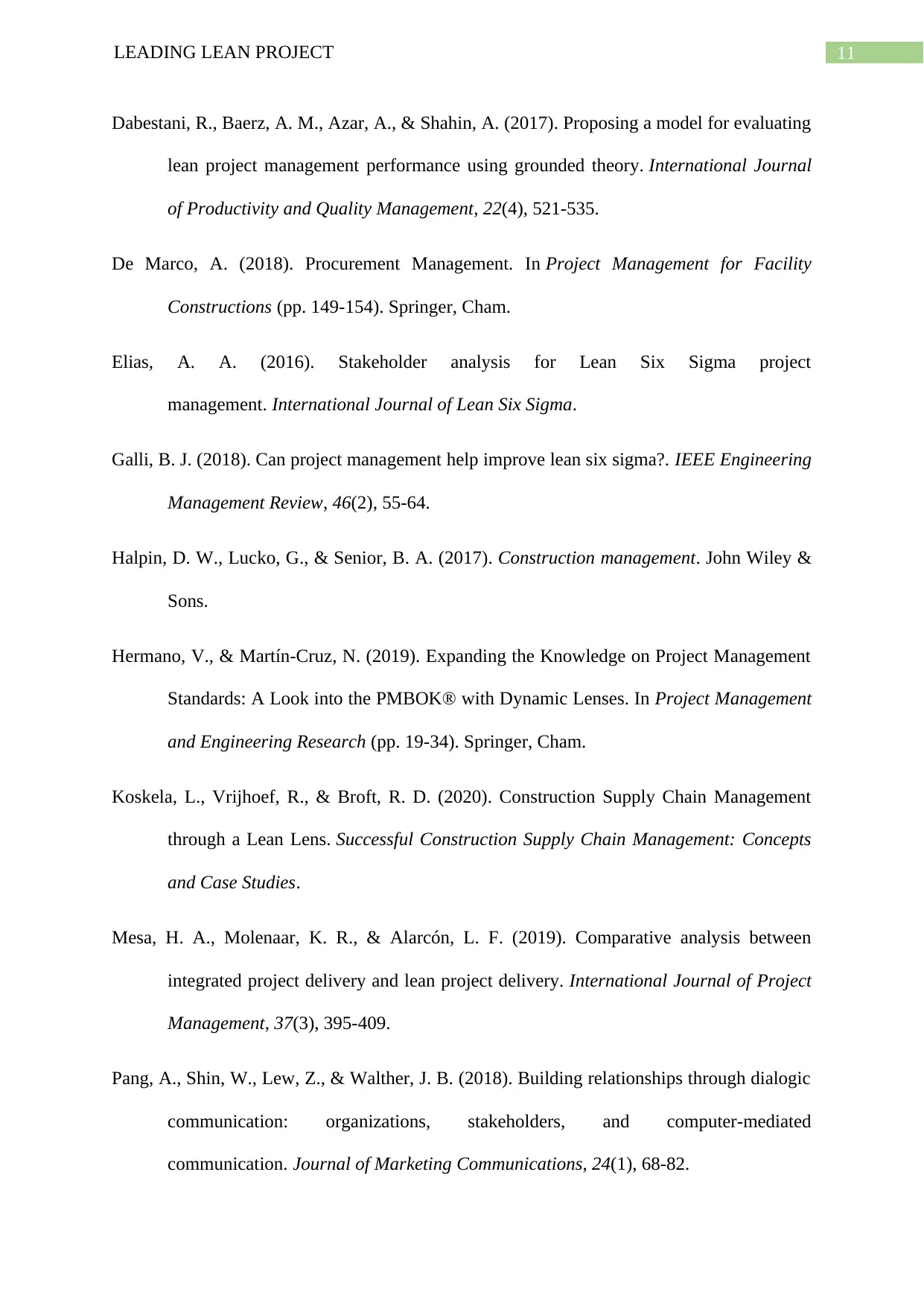
11LEADING LEAN PROJECT
Dabestani, R., Baerz, A. M., Azar, A., & Shahin, A. (2017). Proposing a model for evaluating
lean project management performance using grounded theory. International Journal
of Productivity and Quality Management, 22(4), 521-535.
De Marco, A. (2018). Procurement Management. In Project Management for Facility
Constructions (pp. 149-154). Springer, Cham.
Elias, A. A. (2016). Stakeholder analysis for Lean Six Sigma project
management. International Journal of Lean Six Sigma.
Galli, B. J. (2018). Can project management help improve lean six sigma?. IEEE Engineering
Management Review, 46(2), 55-64.
Halpin, D. W., Lucko, G., & Senior, B. A. (2017). Construction management. John Wiley &
Sons.
Hermano, V., & Martín-Cruz, N. (2019). Expanding the Knowledge on Project Management
Standards: A Look into the PMBOK® with Dynamic Lenses. In Project Management
and Engineering Research (pp. 19-34). Springer, Cham.
Koskela, L., Vrijhoef, R., & Broft, R. D. (2020). Construction Supply Chain Management
through a Lean Lens. Successful Construction Supply Chain Management: Concepts
and Case Studies.
Mesa, H. A., Molenaar, K. R., & Alarcón, L. F. (2019). Comparative analysis between
integrated project delivery and lean project delivery. International Journal of Project
Management, 37(3), 395-409.
Pang, A., Shin, W., Lew, Z., & Walther, J. B. (2018). Building relationships through dialogic
communication: organizations, stakeholders, and computer-mediated
communication. Journal of Marketing Communications, 24(1), 68-82.
Dabestani, R., Baerz, A. M., Azar, A., & Shahin, A. (2017). Proposing a model for evaluating
lean project management performance using grounded theory. International Journal
of Productivity and Quality Management, 22(4), 521-535.
De Marco, A. (2018). Procurement Management. In Project Management for Facility
Constructions (pp. 149-154). Springer, Cham.
Elias, A. A. (2016). Stakeholder analysis for Lean Six Sigma project
management. International Journal of Lean Six Sigma.
Galli, B. J. (2018). Can project management help improve lean six sigma?. IEEE Engineering
Management Review, 46(2), 55-64.
Halpin, D. W., Lucko, G., & Senior, B. A. (2017). Construction management. John Wiley &
Sons.
Hermano, V., & Martín-Cruz, N. (2019). Expanding the Knowledge on Project Management
Standards: A Look into the PMBOK® with Dynamic Lenses. In Project Management
and Engineering Research (pp. 19-34). Springer, Cham.
Koskela, L., Vrijhoef, R., & Broft, R. D. (2020). Construction Supply Chain Management
through a Lean Lens. Successful Construction Supply Chain Management: Concepts
and Case Studies.
Mesa, H. A., Molenaar, K. R., & Alarcón, L. F. (2019). Comparative analysis between
integrated project delivery and lean project delivery. International Journal of Project
Management, 37(3), 395-409.
Pang, A., Shin, W., Lew, Z., & Walther, J. B. (2018). Building relationships through dialogic
communication: organizations, stakeholders, and computer-mediated
communication. Journal of Marketing Communications, 24(1), 68-82.
⊘ This is a preview!⊘
Do you want full access?
Subscribe today to unlock all pages.

Trusted by 1+ million students worldwide
1 out of 13
Related Documents
Your All-in-One AI-Powered Toolkit for Academic Success.
+13062052269
info@desklib.com
Available 24*7 on WhatsApp / Email
![[object Object]](/_next/static/media/star-bottom.7253800d.svg)
Unlock your academic potential
Copyright © 2020–2025 A2Z Services. All Rights Reserved. Developed and managed by ZUCOL.




